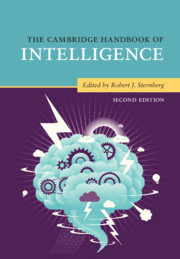Book contents
- The Cambridge Handbook of Intelligence
- The Cambridge Handbook of Intelligence
- Copyright page
- Dedication
- Contents
- Figures
- Tables
- Contributors
- Preface
- Part I Intelligence and Its Measurement
- Part II Development of Intelligence
- Part III Intelligence and Group Differences
- Part IV Biology of Intelligence
- Part V Intelligence and Information Processing
- 20 Basic Processes of Intelligence
- 21 Working Memory and Intelligence
- 22 Intelligence and Reasoning
- 23 Problem-Solving and Intelligence
- 24 Intelligence and Decision-Making
- 25 Artificial Intelligence
- 26 Intelligence and Video Games
- Part VI Kinds of Intelligence
- Part VII Intelligence and Its Role in Society
- Part VIII Intelligence and Allied Constructs
- Part IX Folk Conceptions of Intelligence
- Part X Conclusion
- Author Index
- Subject Index
- References
20 - Basic Processes of Intelligence
from Part V - Intelligence and Information Processing
Published online by Cambridge University Press: 13 December 2019
- The Cambridge Handbook of Intelligence
- The Cambridge Handbook of Intelligence
- Copyright page
- Dedication
- Contents
- Figures
- Tables
- Contributors
- Preface
- Part I Intelligence and Its Measurement
- Part II Development of Intelligence
- Part III Intelligence and Group Differences
- Part IV Biology of Intelligence
- Part V Intelligence and Information Processing
- 20 Basic Processes of Intelligence
- 21 Working Memory and Intelligence
- 22 Intelligence and Reasoning
- 23 Problem-Solving and Intelligence
- 24 Intelligence and Decision-Making
- 25 Artificial Intelligence
- 26 Intelligence and Video Games
- Part VI Kinds of Intelligence
- Part VII Intelligence and Its Role in Society
- Part VIII Intelligence and Allied Constructs
- Part IX Folk Conceptions of Intelligence
- Part X Conclusion
- Author Index
- Subject Index
- References
Summary
Research on human intelligence from a psychological perspective has mainly focused on higher-order cognitive abilities leading to the development and validation of psychometric measures of intelligence such as the IQ test. Despite the success of this movement, there is a lack of understanding on how intelligence measured by IQ tests develops. As such, recent research has focused on studying the basic underlying processes of intelligence. These measures are often referred to as measures of processing speed and collectively as elementary cognitive tasks (ECTs). In this chapter, we review research on two of the most prominent ECTs found in the intelligence literature: reaction time (RT) and inspection time (IT). We describe these measures and variants of these measures in detail and report on studies examining relationships between RT, IT, and intelligence. We describe theories relating to these measures and attempt to understand whether relationships between RT, IT, and intelligence are best described by top-down (strategic) or bottom-up (basic) processes. We outline exciting new areas using pharmacological and neuroimaging techniques that could contribute to this body of knowledge.
Information
- Type
- Chapter
- Information
- The Cambridge Handbook of Intelligence , pp. 471 - 503Publisher: Cambridge University PressPrint publication year: 2020
References
Accessibility standard: Unknown
- 3
- Cited by
